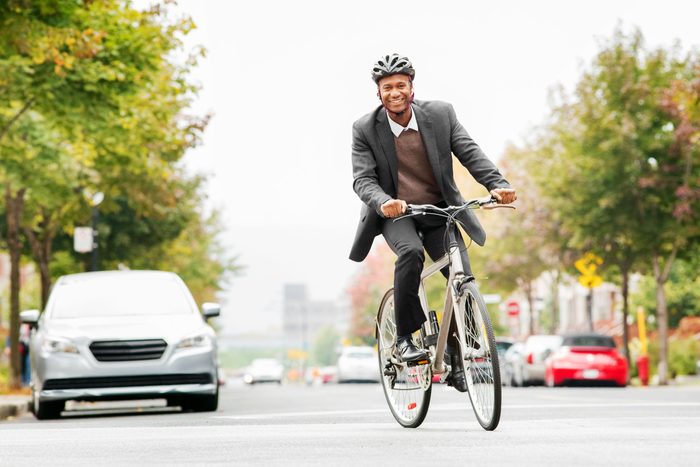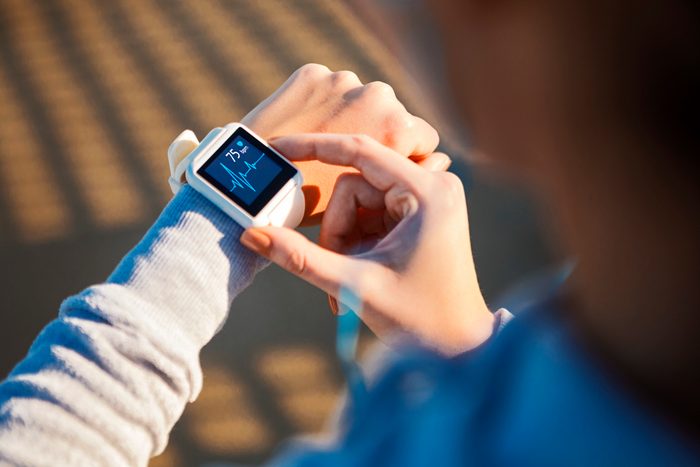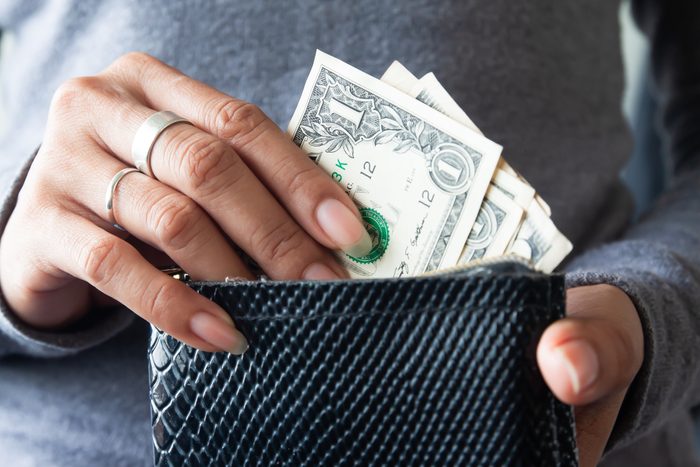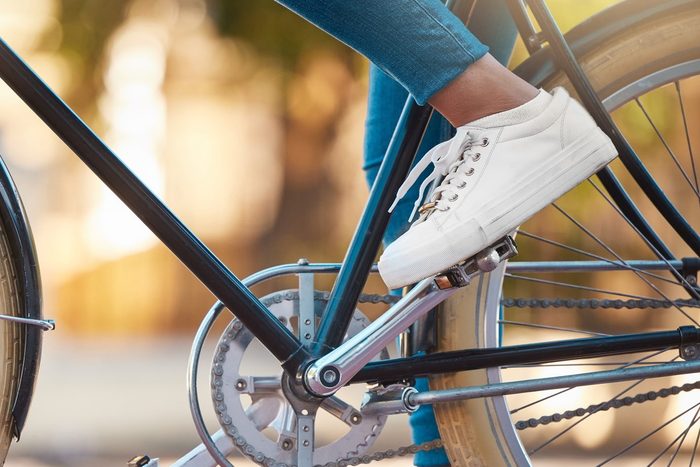
Some people enjoy the commute to work as a space of time to map out the day ahead. For others, that drive (or bus, or train ride) can be a drag. Research from 2018 published in Transport Reviews showed that before the pandemic, the daily commute was a regular source of stress.
If this sounds familiar, you’re probably aware of some main contributors to this trend. The study called out the unpredictability of traffic, low sense of control, and frustration over losing valuable time every day. This stress can continue to spike when we arrive at the office to impact job performance, affect overall mood and even creep into life at home.
But another major discovery from the 2018 findings? The research indicated that people who bike to work tend to cruise straight past this stress, reporting greater well-being and satisfaction throughout their day…in large part, thanks to their bike commute itself.
In fact, one of the few drawbacks associated with a bike commute is its feasibility—like if you have a long way to travel or encounter infrastructure barriers. But there are plenty of ways to work around this, says Anna Tang, Bicycle Friendly America Program Specialist at The League of American Bicyclists. “Sometimes it’s not possible to bike the entire way [to work], but you could drive to a trail or a better location and bike the rest of the way,” Tang says.
Wear your helmet, watch carefully for traffic, and talk with your licensed healthcare provider before you roll on your merry way. Then, here’s how switching to a bike commute could give a big part of your life back in more ways than one.

The health benefits of a bike commute
Cycling is a great all-around workout in general, explains John Solle, National Association of Sports Medicine (NASM) Certified Personal Trainer & Corrective Exercise Specialist and coach at Noom. Biking improves strength, balance and coordination, and a the calories burned from biking can land around 200 to 400 from just a casual ride.
Plus, Solle says, as a low-impact exercise, “many people find it easier to push their heart rate up and increase their level of physical exertion, something that many find challenging with higher-impact exercises like running,” he says.
Here’s How Much Exercise You Need to Counteract Sitting All Day, Says Study

Biking to work is great for your heart
According to US Census data, the average work commute is around 27 minutes—time that can eat into the all-too-limited hours in your day. “We recommend 150 minutes of moderate aerobic exercise a week to improve your heart health,” says Sonia Tolani, MD, a cardiologist specializing in sports cardiology and co-director of the Women’s Heart Center at NewYork-Presbyterian/Columbia University Irving Medical Center. “Sometimes it’s hard to find the time to exercise on a busy day, which is why biking to work is an excellent way to meet your cardio goals.”
Plus, research shows that cycling 20 minutes a day can improve blood pressure, cholesterol, and other contributors to heart disease, lowering your risk of developing the chronic condition.
But, Dr. Tolani says, don’t jump straight into a long bike commute. She advises you start with 10-minute cycling increments. Your goal? “To get to a level of activity where it would be hard to sing a song while you’re doing it,” this heart doctor says.
As you build up your fitness to complete your full commute on a bike, consider Tang’s suggestion: “Incorporate multimodal trip planning,” she says, like using a train or bus for part of your commute and cycling the rest of the way.
The Healthy @Reader’s Digest’s Medical Review Board co-chair Latoya Julce also recommends packing a high-protein breakfast, deodorant, and a change of clothes, especially if you’re biking on a hot day.

A bike commute can be a mental health boost
A 2021 study published in Transportation Research demonstrated that regular bicycling helps to reduce psychological distress, improve life satisfaction, and enhance cognitive function. “Many cyclists feel a strong sense of accomplishment and satisfaction logging long miles and commuting to places under their own power, and this sense of accomplishment is a huge mental boost for many people,” Solle says, adding that biking keeps your brain healthy as well, by combining outdoor stimuli with that exercise.
Beyond that, he says, “When you start biking, you have an opportunity to join a community of cyclists and connect socially with like-minded people.” Social relationships are among the best stress reducers.
Here’s How Exercise Reduces Stress: The 9 Best Moves That Brighten Your Mood

Biking to work could help you live longer
Research published in the Journal of the American Medical Association (JAMA) Internal Medicine in 2021 concluded that regularly taking short-to-medium distance bike trips is associated with a reduced risk of premature death, including death due to existing conditions like diabetes and heart disease.
Tang points to another study from the Minnesota Department of Transportation that showed commuting by bike just three times a week was linked with a 46% lower risk of metabolic syndrome (diabetes is one example), 32% lower risk of obesity, and 28% lower risk of hypertension.
Feeling Thankful Can Help Prevent These 7 Major Diseases, Says Research

A bike commute can save you money
Even if you have a car you use throughout the week, you’ll save some serious cash in fuel and maintenance expenses by opting to hop on a bike for your commute. A study from Ecological Economics suggested that it’s six times more expensive for the average person to drive to work instead of bike—and that data is from 2015, when average gas prices were significantly lower than they are today.
In addition, health insurance company Blue Cross Blue Shield found that physically active people spend $4,438 less on medical expenses over a four-year period than people who don’t exercise regularly.
These savings appear to continue into the long term, according to a 2021 study published in the British Medical Journal (BMJ) Open Sport & Exercise Medicine. The research showed that people who started to exercise before or during middle age saved between $824 and $1,874 annually on healthcare even after retirement.

It lowers your carbon footprint
“The environmental impact of biking to work versus driving is huge,” Tang says. According to the Environmental Protection Agency (EPA), the transportation sector is the largest contributor to greenhouse gas emissions that drive climate change. “Bicycling to work essentially has a zero carbon footprint,” she says.
A study from Transportation Research drives this home: Cyclists, on average, leave an 84% lower daily carbon footprint than vehicle drivers. If that helps to ease any climate anxiety you feel, that’s a health win for sure.

